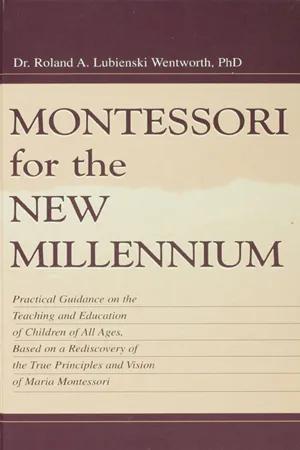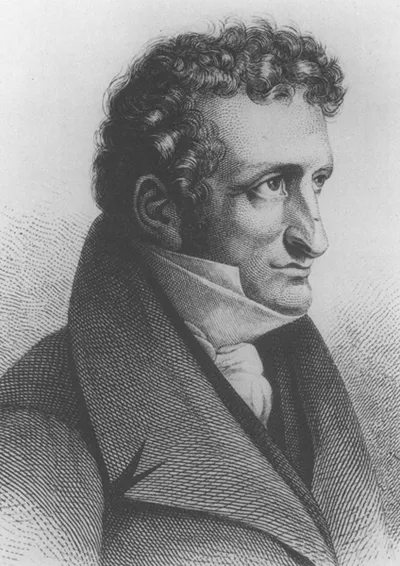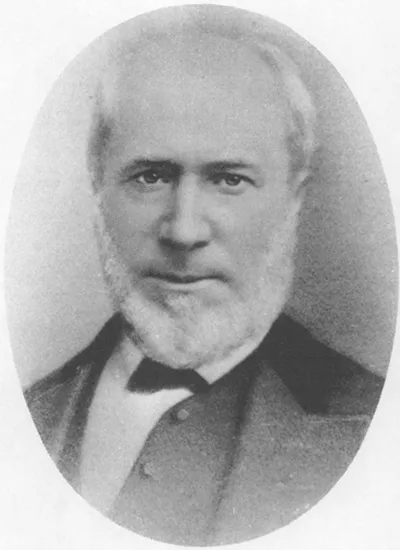![]()
1
The Principles of the Montessori System
One of the main ideas underlying the Montessori system was that education should fully develop children’s positive potentials, so they can become happy and useful members of society. Like some of her eminent predecessors (e.g. Hume and Rousseau), Montessori believed the best way to achieve this was to see that education suits the child’s nature and inclinations. To fulfill this purpose, she said, it is necessary to base the method on scientific principles drawn from firsthand investigation in schools.
Like all general statements and definitions, this brief summary of Montessori’s intentions falls short of much that cannot be briefly explained, although the gist of them is therein1. Brought up in the early years of the growth of modern democracy, and imbued with the enthusiastic optimism that her early experiments with children seemed to justify, she firmly believed the result would support the liberalizing tendencies of the early 20th century; which is also perhaps why her system finds growing support in the late 1990s, in the postcolonial era with its strong emphasis on individual rights.
In Montessori’s conception, the purpose of education is to help develop a free child, one who knows what it wants to be and do. She thought a free child would not later be inclined to accept dictatorial rule, nor to give in to the demands of an oppressive regime. She wrote:
The child is the first part of the adult’s life; indeed it is the builder of the adult. The good or the bad in the grown man is closely connected with the life of the child from which he came. The child is the whole of future humanity … The social question of the child leads naturally to a desire to try to find out the laws of man’s formation, so helping us to create a new conscience and giving a new direction to our social life2
Montessori believed that nature has given children the right positive inclinations for becoming a happy member of a peaceful society, and that given favorable conditions, the child’s positive qualities will develop and the ills of adult society will be cured. But one must distinguish between science and moral or social philosophy. As an educational scientist, Montessori could not take it on herself to decide what should be the political aims of educational development of a country. She could only indicate the most effective and psychologically sound method for bringing up well-integrated and happy human beings, able to form an integrated society. It would be for its members themselves to choose the type of social organization of which they would wish to be part. But would a generation of people brought up in freedom choose a regime that oppressed it? Montessori did not think so, hence her optimism for the future of a society educated in her schools3.
This whole issue of free education had arisen long before Montessori John Locke, in his book, Some Thoughts Concerning Education published in 1693, was the first to point out that teaching should vary according to the nature of the person taught, and that it should not have to be forced on people, because a lesson learned under pressure has only a superficial effect and is soon forgotten. Thus, we have known the truth of this statement for at least 300 years. But it was Montessori who discovered the way to make children learn while leaving them free4. She was one of the first to base her system on a scientific observation of children. She personally showed how to conduct an educational experiment scientifically, and encouraged future experiments of this kind to be carried out by others.
But neither her teaching aids, now summarily called the Montessori material, nor the technique of presenting them to the children, were her own inventions. Their originators were her French predecessors, Itard and Seguin, whose patient investigations were aimed at developing techniques for educating mentally handicapped children5. Montessori’s main contribution was to point out the need to apply the same scientific process to normal boys and girls. The Itard-Seguin didactic methods used for mentally handicapped children led to a realization of two main facts: First, that children can learn to control their limbs and acquire elementary knowledge very much earlier than was previously believed; and second, that there are a number of distinct phases in children’s development during each of which certain skills are more easily learned than either before or later, and each in turn making way for others.
Dr. Jean-Marc-Gaspard Itard. Born 1775. Died 1838. French physician. One of Maria Montessori’s two main precursors and sources of inspiration. From about 1800, became interested in teaching deaf and developmentally retarded children. Photo: Hulton Getty Picture Collection, London, England.
Dr. Edouard Séguin. Born January 20,1812, Clamecy, France. Died October 28,1880, New York City. French-born American psychiatrist. As a young man, he worked with Dr. Itard. In 1839 he opened a school for severely retarded children. To aid in teaching them he developed a variety of tactile material, which inspired Montessori. Photo: Economica, Paris, France.
Montessori supervised the first experiment on normal children in the famous Casa dei Bambini (Children’s House) in Rome, and as a result of her inspiration and writings, similar preschool establishments, and further developments of the method, spread gradually worldwide. The experience gained in the preschools pointed the way to an extension of the method in two different directions: First, downward in age to babies from the very first days of their life; and second, upward in age to children of school age.
Montessori died in 1952, aged, respected, and admired by her many disciples. But the momentum of the movement for children’s rights that she had started seems to have been lost through the double interruption of the two world wars, the banishment of her schools from Italy and Germany, and a general indifference on the part of official educational authorities everywhere. Since World War II, in particular, the new generation of educators and official lecturers has tended to regard Montessori as a figure belonging to the past, who of course had her place in the history of education, along with others such as Rousseau, Pestalozzi, and Froebel (whose teachings have already been assimilated into the modern theory of education), and are therefore no longer important — rather like those of the old philosophers whose ideas have by now been written down and classified, and have given way to new thinkers with their own original theories. Yet despite this indifference, Montessori schools and training colleges have somehow survived and continued their work in the private sector; and as if the death of the old pioneer acted to remind educational circles of their existence, a revival of the Montessori movement started to take place, chiefly in America, in the early 1950s, backed by modern writers in educational psychology. The experiments of Piaget, the new educational guru, confirmed the existence of phases in the development of the child’s mind and comprehension. The stage was set for “the method” to come out of the closet of the private sector into the open field of public education.
In our modern world, beset by problems that recurrently assume international proportions, it has become common (and with good reason, too) to put the blame for most social evils on inadequate education. However, the educational theories of our age seem to swing between two extremes: excessive rigidity on the one hand and chaos on the other, neither of which is able to cope with the problems of present day society. The Montessori system lies roughly between the two extremes. Based not only on sound general theory but also tested in solid practical classroom experience, it offers freedom without anarchy, and discipline without rigidity.
One fact clearly stands out: Apart from some experiments made during her time spent in India, Montessori was never able to create a complete well- tested school program for children ages 6 to 9 or older. Hence, whatever materials and methods are used for children of mandatory school age, they should be subjected to the same degree of scientific investigation as were the Montessori preschools. And even the preschools themselves, if they are to reflect truly the spirit of Montessori education, should be undergoing continual revision and modification according to the changing times and different needs of new generations of children. This principle has to some extent been recognized by Montessori schools in the United States and in a number of other countries by the introduction of a more diversified environment and a number of new, Montessori-oriented materials. However, the original implements and methods introduced by Itard and Seguin, such as the sensorial apparatus, movable alphabet letters, and the beads for arithmetic, are still the predominant feature.
Because there is no established pattern to show how an elementary school is to be run on Montessori lines, and Montessori is no longer here to guide us, the only way to found a school that can justifiably be called Montessorian is to examine some of the characteristics inherent in the environment, materials and method used in the Montessori preschool, to see if they could conceivably be applied to the education of older children. Qualified educators need to investigate and test the value of various educational materials and methods and discuss it openly among themselves. But not all teachers are suited for such research. Therefore, the question of whether some material or teaching practice genuinely reflects the Montessori ideal, and whether it has a desirable effect on children, is something that needs to be explored by academic institutions with experts in educational research.
It is important to stress that in general educational terminology the term Montessori education does not signify any particular proprietary rights or franchise attached to some particular material or teaching device, but rather a type of education, a set of principles, and a philosophy associated with and reflected in the works of Maria Montessori. Conceiving it in this way, it is possible to imagine a teacher creating a Montessori school even in a jungle, far away from civilized life and without any resources for buying Montessori materials from a factory. She would use her ingenuity, and whatever raw materials were available in the vicinity, to produce “tools” appropriate to the children’s needs in relation to the level of civilization in which they were going to live. In the same way, it is perfectly possible for a poor village school in a civilized country, unable to purchase any standard Montessori equipment, to apply the general principles of the method and provide such materials as can be bought cheaply or made by the teacher’s own hands, thus creating a genuine Montessori environment.
The name Montessori is in a way like that of Froebel, whose kindergartens (children’s gardens) became even more famous than Montessori’s Children’s Houses. Who would expect the Froebel Institute to keep uniquely to the materials and methods Froebel had introduced? The Froebel schools support everything that in their opinion is good for the child, thus entering into the spirit of their founder’s prescriptions, and as a result achieving standards far above anything dreamed of by Froebel himself. But in following Montessori’s footsteps, there is more than a general idea to interpret. There are definite principles and specific educational practices tested many times in schools in various countries and at different levels of civilization.
When a visitor, entering a classroom, finds the children walking on a painted line round the room, or sitting motionless, almost holding their breath during a lesson of silence, or deeply immersed in some calculation with the help of little seeds or stones, he will recognize that it is a Montessori classroom — even if none of the classical beads, bells, or colored tablets are in use. But even if none of these traditional practices are to be seen, there are some general directives, some specific rules based on an intimate knowledge of children’s nature and proved in their efficacy, which make a Montessori classroom what it is: a children’s community, with a teacher discreetly in the background, a place free from unnecessary restrictions, and yet disciplined, with children enjoying work without being compelled to do it — a true miracle as it was called when it was first seen in the San Lorenzo slum district of Rome.
Here I discuss what are these specific rules and principles, that give Montessori schools their particular character.
The highlights of the system were brilliantly summarized by Montessori in a series of six talks she gave at the Montessori International Conference in Amsterdam, Holland in 1933. I have in my possession the transcript of five of these lectures in French, together with a summary of the sixth made by my first wife Hélêne Lubienska de Lenval. The following pages are based on those manuscripts.
First, Montessori said that nature has provided the child with an instinct that gives it a powerful urge to explore the surrounding world and become independent of grown-up help. It is that same instinct that drives birds to try their wings to fly, and compels all young animals to search for food, shelter, and the satisfaction of their various needs independently of their parents. Fully-grown animals do not oppose this tendency in their young, do not hinder their development by overprotection, but often help it. Thus, birds push their young out of the nest when the time is ripe, ducks lead their ducklings into the water, and so on. Human adults often fail to understand this tendency in their children, and either stop them from exploring their surroundings or hinder their movements by confining them to narrow playpens and cots and tight clothes, or by feeding them, dressing them, and doing most things for them instead of letting them learn how to do these tasks for themselves. As a result, those children do not develop normally but instead become frustrated, bored, discouraged, and angry, and may acquire the negative traits by which they are commonly known such as unreasonable behavior, changing moods, crying, impatience, mischievousness, disobedience, and laziness.
The way to prevent these DEVIATIONS, as Montessori called them, is to provide children with a suitable environment in which they are able to learn to be independent, without being hindered by grown-ups. A deviated child can become “cured” if it is put into a suitable environment while it is still at a receptive age (normally before it is 4 or 5 years old).
Second, if the environment is to have its effect, the parent or teacher must not be in a commanding position, like a dictator, compelling children to do certain jobs or assignments under threat of penalties. A Montessori educator should be like a waitress, who faces her customers, offers them the menu and serves them well-prepared dishes, or like a laboratory assistant who introduces the students to the right way of handling scientific apparatus, or a librarian who gives the readers the required guidance for finding the books they desire. Montessori called the resulting change produced in deviated children through this way of teaching, NORMALIZATION. It is a condition in which the child and educator work in unison, without opposition. The child works freely and happily with the materials supplied to it, at a pace suiting its own nature, without the motivation of rewards and punishments, or being spurred unduly by competition, or compelled by the requests of the teacher.
Montessori used the term Normalization because of her conviction that putting a child in a proper, natural environment, will enable it to revert to its “normal,” sociable self, thus ending any further trouble for educators.
This conversion begins the moment the child becomes deeply immersed in an occupation, and as a result develops a power of concentration and acquires a love of learning and acquiring new skills. The child becomes independent, self-disciplined, responsible, happy, and sociable. Thus, a salient characteristic of the Montessori method is that character building goes hand in hand with intellectual development, so that one is an essential concomitant of the other.
As the child becomes addicted to work, its character changes for the better. Montessori believed the first step toward sensible education is to keep the child in its normal condition and, if the child is already deviated, to normalize it. All other guidelines, namely the creation of an appropriate environment, the provision of suitable materials, enabling the child to progress at its own pace, and so forth, are dictated by the fact that they lead to and maintain a normalized state of mind.
But the methods must be of a positive kind, by encouraging and gently stimulating, because negative methods cause opposite reactions and hinder the development of positive and creative energies. Helping children too much, or providing them with ready answers to problems, is also a negative factor because it prevents the child from using its own resources for knowledge acquisition, and deprives the child of the pleasure of discovery.
Montessori considered her own achievements as only the beginning of a scientific and exp...


